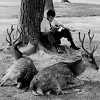Romanticism and Ecopoetics
DOI:
https://doi.org/10.51777/relief12337Keywords:
romanticism, ecopoetics, poetry, feeling, nature, landscapeAbstract
The reception of romanticism by contemporary ecopoetics shows two opposing tendencies: on the one hand, the recognition of a parentage or even the claim of an inheritance; on the other, a mistrust or even rejection of romanticism, which testifies to a certain ignorance of its complexity and diversity. The romantic feeling towards nature is often suspected of renewing an anthropocentric or even egocentric attitude towards nature. This article intends to show that, far from being the simple projection of the affects of the subject onto the outside world, this feeling results from an interaction between the inside and the outside, of which the landscape is the privileged place and which engages a state of the body as much as a state of mind. Rereading in the light of ecopoetics some of its most radical expressions, chosen from Wordsworth, Shelley, Byron, Goethe, Senancour, Guérin, or George Sand, we point out a visceral link between human beings and their environment, illustrating the contribution of romanticism to the emergence of an ecological consciousness.
Downloads

Downloads
Published
Issue
Section
License
Copyright (c) 2022 Michel Collot

This work is licensed under a Creative Commons Attribution 4.0 International License.
All articles published in RELIEF appear in Open Access under the Creative Commons Attribution 4.0 International License (CC-BY 4.0). Under this licence, authors retain ownership of the copyright of their article, but they allow its unrestricted use, provided it is properly cited.






